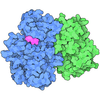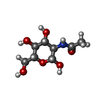[English] 日本語
 Yorodumi
Yorodumi- PDB-9ipb: Local refinement structure of sEGFR and 528 Fv (from LH-type bisp... -
+ Open data
Open data
- Basic information
Basic information
| Entry | Database: PDB / ID: 9ipb | ||||||||||||||||||||||||
|---|---|---|---|---|---|---|---|---|---|---|---|---|---|---|---|---|---|---|---|---|---|---|---|---|---|
| Title | Local refinement structure of sEGFR and 528 Fv (from LH-type bispecific diabody Ex3) complex | ||||||||||||||||||||||||
 Components Components |
| ||||||||||||||||||||||||
 Keywords Keywords | ANTITUMOR PROTEIN/IMMUNE SYSTEM / bispecific antibody / diabody / EGFR / LH / Ex3 / 528 / local refinement / ANTITUMOR PROTEIN / ANTITUMOR PROTEIN-IMMUNE SYSTEM complex | ||||||||||||||||||||||||
| Function / homology |  Function and homology information Function and homology informationmultivesicular body, internal vesicle lumen / negative regulation of cardiocyte differentiation / Shc-EGFR complex / positive regulation of protein kinase C signaling / Inhibition of Signaling by Overexpressed EGFR / epidermal growth factor receptor activity / EGFR interacts with phospholipase C-gamma / regulation of peptidyl-tyrosine phosphorylation / epidermal growth factor binding / response to UV-A ...multivesicular body, internal vesicle lumen / negative regulation of cardiocyte differentiation / Shc-EGFR complex / positive regulation of protein kinase C signaling / Inhibition of Signaling by Overexpressed EGFR / epidermal growth factor receptor activity / EGFR interacts with phospholipase C-gamma / regulation of peptidyl-tyrosine phosphorylation / epidermal growth factor binding / response to UV-A / PLCG1 events in ERBB2 signaling / ERBB2-EGFR signaling pathway / morphogenesis of an epithelial fold / PTK6 promotes HIF1A stabilization / ERBB2 Activates PTK6 Signaling / digestive tract morphogenesis / Signaling by EGFR / intracellular vesicle / negative regulation of epidermal growth factor receptor signaling pathway / eyelid development in camera-type eye / cerebral cortex cell migration / protein insertion into membrane / ERBB2 Regulates Cell Motility / protein tyrosine kinase activator activity / Respiratory syncytial virus (RSV) attachment and entry / Signaling by ERBB4 / PI3K events in ERBB2 signaling / positive regulation of phosphorylation / positive regulation of peptidyl-serine phosphorylation / Estrogen-dependent nuclear events downstream of ESR-membrane signaling / hair follicle development / MAP kinase kinase kinase activity / GAB1 signalosome / positive regulation of G1/S transition of mitotic cell cycle / embryonic placenta development / salivary gland morphogenesis / Signaling by ERBB2 / TFAP2 (AP-2) family regulates transcription of growth factors and their receptors / GRB2 events in EGFR signaling / transmembrane receptor protein tyrosine kinase activity / SHC1 events in EGFR signaling / EGFR Transactivation by Gastrin / GRB2 events in ERBB2 signaling / ossification / SHC1 events in ERBB2 signaling / basal plasma membrane / positive regulation of DNA repair / cellular response to epidermal growth factor stimulus / positive regulation of DNA replication / epithelial cell proliferation / positive regulation of epithelial cell proliferation / Signal transduction by L1 / positive regulation of protein localization to plasma membrane / NOTCH3 Activation and Transmission of Signal to the Nucleus / cellular response to amino acid stimulus / phosphatidylinositol 3-kinase/protein kinase B signal transduction / cellular response to estradiol stimulus / EGFR downregulation / clathrin-coated endocytic vesicle membrane / Signaling by ERBB2 TMD/JMD mutants / Constitutive Signaling by EGFRvIII / cell-cell adhesion / receptor protein-tyrosine kinase / Signaling by ERBB2 ECD mutants / Signaling by ERBB2 KD Mutants / negative regulation of protein catabolic process / positive regulation of miRNA transcription / kinase binding / ruffle membrane / Downregulation of ERBB2 signaling / epidermal growth factor receptor signaling pathway / positive regulation of protein phosphorylation / positive regulation of fibroblast proliferation / cell morphogenesis / neuron differentiation / HCMV Early Events / Constitutive Signaling by Aberrant PI3K in Cancer / actin filament binding / cell junction / transmembrane signaling receptor activity / positive regulation of canonical Wnt signaling pathway / Cargo recognition for clathrin-mediated endocytosis / PIP3 activates AKT signaling / Constitutive Signaling by Ligand-Responsive EGFR Cancer Variants / Clathrin-mediated endocytosis / virus receptor activity / ATPase binding / PI5P, PP2A and IER3 Regulate PI3K/AKT Signaling / RAF/MAP kinase cascade / positive regulation of cell growth / double-stranded DNA binding / protein tyrosine kinase activity / early endosome membrane / protein phosphatase binding / nuclear membrane / basolateral plasma membrane / learning or memory / cell surface receptor signaling pathway / Extra-nuclear estrogen signaling / positive regulation of ERK1 and ERK2 cascade Similarity search - Function | ||||||||||||||||||||||||
| Biological species |  Homo sapiens (human) Homo sapiens (human)synthetic construct (others) | ||||||||||||||||||||||||
| Method | ELECTRON MICROSCOPY / single particle reconstruction / cryo EM / Resolution: 2.93 Å | ||||||||||||||||||||||||
 Authors Authors | Sato, K. / Uehara, S. / Tsugita, A. / Matsui, T. / Asano, R. / Makabe, K. / Yokoyama, T. / Tanaka, Y. | ||||||||||||||||||||||||
| Funding support |  Japan, 1items Japan, 1items
| ||||||||||||||||||||||||
 Citation Citation |  Journal: Cell Rep / Year: 2025 Journal: Cell Rep / Year: 2025Title: Bispecific antibody-antigen complex structures reveal activity enhancement by domain rearrangement. Authors: Kyohei Sato / Shiro Uehara / Atsushi Tsugita / Mayuka Ishii / Shieru Ishiyama / Atsushi Maejima / Ishin Nakahara / Misae Nazuka / Takashi Matsui / Gatsogiannis Christos / Takeshi Yokoyama / ...Authors: Kyohei Sato / Shiro Uehara / Atsushi Tsugita / Mayuka Ishii / Shieru Ishiyama / Atsushi Maejima / Ishin Nakahara / Misae Nazuka / Takashi Matsui / Gatsogiannis Christos / Takeshi Yokoyama / Izumi Kumagai / Koki Makabe / Ryutaro Asano / Yoshikazu Tanaka /   Abstract: Bispecific antibodies (BsAbs) have been developed as anti-cancer drugs that accumulate activated T cells on cancer cells by bridging the antigens present in each cell. Ex3 is a diabody-type BsAb ...Bispecific antibodies (BsAbs) have been developed as anti-cancer drugs that accumulate activated T cells on cancer cells by bridging the antigens present in each cell. Ex3 is a diabody-type BsAb composed of an anti-epidermal growth factor receptor (EGFR) antibody and an anti-CD3 antibody. In the design of Ex3, the LH-type domain order (Ex3LH) is shown to have more than 100-fold greater anti-cancer activity than the HL-type domain order (Ex3HL). To understand this phenomenon of activity enhancement by domain-order rearrangement, we report here cryoelectron microscopy (cryo-EM) structures of both Ex3HL and Ex3LH in complex with EGFR and CD3. A structural comparison of the HL and LH types reveals that the domain rearrangement leads to drastic structural changes and that the avoidance of steric hindrance by a favorable bridging angle on the cell surface is the fundamental mechanism for this activity enhancement. | ||||||||||||||||||||||||
| History |
|
- Structure visualization
Structure visualization
| Structure viewer | Molecule:  Molmil Molmil Jmol/JSmol Jmol/JSmol |
|---|
- Downloads & links
Downloads & links
- Download
Download
| PDBx/mmCIF format |  9ipb.cif.gz 9ipb.cif.gz | 166.3 KB | Display |  PDBx/mmCIF format PDBx/mmCIF format |
|---|---|---|---|---|
| PDB format |  pdb9ipb.ent.gz pdb9ipb.ent.gz | 127.4 KB | Display |  PDB format PDB format |
| PDBx/mmJSON format |  9ipb.json.gz 9ipb.json.gz | Tree view |  PDBx/mmJSON format PDBx/mmJSON format | |
| Others |  Other downloads Other downloads |
-Validation report
| Summary document |  9ipb_validation.pdf.gz 9ipb_validation.pdf.gz | 1.3 MB | Display |  wwPDB validaton report wwPDB validaton report |
|---|---|---|---|---|
| Full document |  9ipb_full_validation.pdf.gz 9ipb_full_validation.pdf.gz | 1.4 MB | Display | |
| Data in XML |  9ipb_validation.xml.gz 9ipb_validation.xml.gz | 44.1 KB | Display | |
| Data in CIF |  9ipb_validation.cif.gz 9ipb_validation.cif.gz | 63.6 KB | Display | |
| Arichive directory |  https://data.pdbj.org/pub/pdb/validation_reports/ip/9ipb https://data.pdbj.org/pub/pdb/validation_reports/ip/9ipb ftp://data.pdbj.org/pub/pdb/validation_reports/ip/9ipb ftp://data.pdbj.org/pub/pdb/validation_reports/ip/9ipb | HTTPS FTP |
-Related structure data
| Related structure data |  60768MC  9ip7C  9ip8C  9ip9C  9ipaC  9ipcC  9ipdC  9ipeC M: map data used to model this data C: citing same article ( |
|---|---|
| Similar structure data | Similarity search - Function & homology  F&H Search F&H Search |
- Links
Links
- Assembly
Assembly
| Deposited unit | 
|
|---|---|
| 1 |
|
- Components
Components
| #1: Protein | Mass: 69496.062 Da / Num. of mol.: 1 Source method: isolated from a genetically manipulated source Source: (gene. exp.)  Homo sapiens (human) / Gene: EGFR, ERBB, ERBB1, HER1 / Production host: Homo sapiens (human) / Gene: EGFR, ERBB, ERBB1, HER1 / Production host:  References: UniProt: P00533, receptor protein-tyrosine kinase | ||||||
|---|---|---|---|---|---|---|---|
| #2: Antibody | Mass: 26651.629 Da / Num. of mol.: 1 / Mutation: Y52W Source method: isolated from a genetically manipulated source Source: (gene. exp.) synthetic construct (others) / Production host:  Brevibacillus choshinensis (bacteria) Brevibacillus choshinensis (bacteria) | ||||||
| #3: Polysaccharide | Source method: isolated from a genetically manipulated source #4: Sugar | Has ligand of interest | N | Has protein modification | Y | |
-Experimental details
-Experiment
| Experiment | Method: ELECTRON MICROSCOPY |
|---|---|
| EM experiment | Aggregation state: PARTICLE / 3D reconstruction method: single particle reconstruction |
- Sample preparation
Sample preparation
| Component |
| ||||||||||||||||||||||||
|---|---|---|---|---|---|---|---|---|---|---|---|---|---|---|---|---|---|---|---|---|---|---|---|---|---|
| Source (natural) |
| ||||||||||||||||||||||||
| Source (recombinant) |
| ||||||||||||||||||||||||
| Buffer solution | pH: 7.4 | ||||||||||||||||||||||||
| Specimen | Embedding applied: NO / Shadowing applied: NO / Staining applied: NO / Vitrification applied: YES | ||||||||||||||||||||||||
| Vitrification | Cryogen name: ETHANE |
- Electron microscopy imaging
Electron microscopy imaging
| Microscopy | Model: JEOL CRYO ARM 300 |
|---|---|
| Electron gun | Electron source:  FIELD EMISSION GUN / Accelerating voltage: 300 kV / Illumination mode: FLOOD BEAM FIELD EMISSION GUN / Accelerating voltage: 300 kV / Illumination mode: FLOOD BEAM |
| Electron lens | Mode: BRIGHT FIELD / Nominal defocus max: 2400 nm / Nominal defocus min: 900 nm |
| Image recording | Electron dose: 60 e/Å2 / Film or detector model: GATAN K3 (6k x 4k) |
- Processing
Processing
| EM software | Name: PHENIX / Category: model refinement |
|---|---|
| CTF correction | Type: PHASE FLIPPING AND AMPLITUDE CORRECTION |
| 3D reconstruction | Resolution: 2.93 Å / Resolution method: FSC 0.143 CUT-OFF / Num. of particles: 1085217 / Symmetry type: POINT |
| Refinement | Highest resolution: 2.93 Å Stereochemistry target values: REAL-SPACE (WEIGHTED MAP SUM AT ATOM CENTERS) |
 Movie
Movie Controller
Controller









 PDBj
PDBj
















